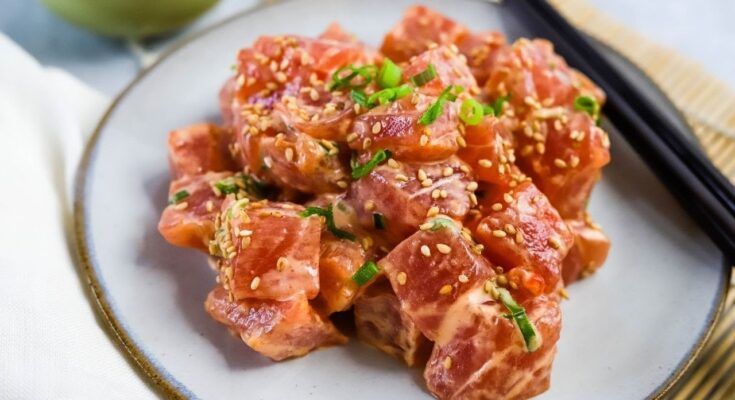Ahi Poke Recipe: Ahi Poke (pronounced “po-kay”) is one of those Hawaiian delights that captures your taste buds from the very first bite. It’s a raw fish salad typically made with cubed ahi (yellowfin tuna), marinated in soy sauce, sesame oil, and other flavorful ingredients. Think of it like the Hawaiian cousin to sashimi or ceviche—but with a flavor profile all its own. It’s light, refreshing, and packs a punch of umami that sushi lovers can’t get enough of.
What makes poke stand out is its simplicity and purity. It relies on fresh ingredients and balanced flavors to let the tuna shine. Whether you’re enjoying it on the beach in Maui or making it at home, poke offers a taste of the islands that’s perfect for lunch, dinner, or even a healthy snack.
History and Cultural Significance
The origins of poke go back centuries in Hawaiian culture. The word “poke” means “to slice” or “to cut crosswise into pieces” in Hawaiian. Native Hawaiians would traditionally prepare poke with raw reef fish seasoned with sea salt, seaweed, and crushed kukui nuts. When Japanese immigrants brought soy sauce and sesame oil to the islands, the modern version of poke was born—combining local and Asian flavors in a perfect fusion.
Today, poke has exploded in popularity across the globe, especially in the U.S. mainland. Poke bowls are now a staple at many fast-casual restaurants, but the dish remains a symbol of Hawaiian hospitality and culinary simplicity.
Why Ahi Poke is a Must-Try Dish
If you’ve never tried ahi poke, you’re seriously missing out. First off, it’s incredibly easy to make. With just a few fresh ingredients and a bit of patience, you can whip up a restaurant-quality dish at home in under 30 minutes.
Beyond its flavor, poke is also packed with health benefits. Ahi tuna is rich in lean protein, omega-3 fatty acids, and essential nutrients. When combined with low-sodium soy sauce, fresh vegetables, and a touch of sesame, it’s a clean-eating dream come true.
Plus, it’s endlessly customizable. Want it spicy? Add sriracha or chili flakes. Prefer a sweeter twist? Try a dash of mirin or mango chunks. The base recipe can be tailored to fit any palate, making it ideal for dinner parties, family meals, or solo indulgence.
Ingredients for Authentic Ahi Poke
Choosing the Right Ahi Tuna
Your poke is only as good as your tuna. The key is to find sushi-grade or sashimi-grade ahi tuna. Look for bright red, firm flesh with no fishy odor. If you’re unsure, ask your local fishmonger for sushi-grade tuna—this ensures it’s been frozen to the correct temperature to kill parasites, making it safe for raw consumption.
Freshness is everything here. Avoid tuna that’s dull, mushy, or has a sour smell. If fresh isn’t available, high-quality frozen tuna can be a solid backup—just be sure to thaw it properly in the fridge and pat it dry before use.
Must-Have Marinade Components
The magic of ahi poke lies in its marinade. Here’s a basic list of must-have ingredients:
- Soy Sauce (Shoyu): Adds savory umami depth.
- Sesame Oil: A little goes a long way in delivering that nutty, toasty aroma.
- Green Onions: Bright, fresh, and aromatic.
- Sweet Onion or Maui Onion: Adds a mild sweetness to balance the saltiness.
- Sesame Seeds: For crunch and a nutty finish.
Some people also add a touch of rice vinegar for acidity, or a dash of Hawaiian sea salt for a more authentic feel.
Optional Add-ins for Personalization
Want to put your own spin on the classic poke? Here are some great additions:
- Avocado: Creamy texture and healthy fats.
- Cucumber: For crunch and freshness.
- Chili Flakes or Sriracha: If you like it hot.
- Macadamia Nuts or Crushed Peanuts: Adds extra crunch and a unique flavor.
- Seaweed (Limu): Traditional and super nutritious.
The key is not to overload the bowl. Let the tuna remain the star of the show while the add-ins complement without overpowering.
Preparing Ahi Poke at Home
Step 1: Source and Prep Your Tuna
This is the foundation of any great poke bowl—getting your hands on quality ahi tuna and prepping it properly. Start by visiting a reputable fish market or grocery store that carries sushi-grade fish. If you’re unsure about the quality, just ask! Most stores are happy to help.
Once you’ve got your ahi tuna, keep it refrigerated until you’re ready to use it. When you’re ready to start, rinse the tuna briefly under cold water and pat it dry with a paper towel. Next, using a sharp knife, cut the tuna into uniform ¾-inch cubes. This size strikes the perfect balance between bite-sized and hearty.
One big tip here: always cut against the grain. This keeps the fish tender and easier to chew. Don’t rush the cutting process. Clean, consistent cubes mean better presentation and more even marination.
After cutting, place the tuna cubes into a clean mixing bowl and return it to the fridge while you prep the rest of the ingredients. Keeping it cold is key to maintaining texture and flavor.
Step 2: Create the Marinade
Here’s where the magic begins. In a separate bowl, whisk together your core ingredients:
- ¼ cup soy sauce (shoyu)
- 1 teaspoon sesame oil
- 2 tablespoons chopped green onions
- 2 tablespoons finely diced sweet onion
- 1 teaspoon toasted sesame seeds
You can adjust these measurements depending on your taste preference or the amount of tuna you’re using. Want more umami? Add a bit more soy. Craving spice? Stir in a teaspoon of sriracha or a sprinkle of red pepper flakes.
Once your marinade is ready, taste it. Yes, before it even touches the fish! It should be savory, slightly nutty, and balanced with the sweetness of onions. If it’s too salty, balance it with a touch of mirin or a squeeze of lime juice.
Now pour this delicious mixture over the tuna cubes. Use a spoon or your (clean) hands to gently mix until all the pieces are coated evenly. Be gentle—you don’t want to mash the fish.
Cover the bowl with plastic wrap and refrigerate for 15–30 minutes. This short marinating period allows the flavors to develop without overpowering the fresh tuna.
Step 3: Combine and Chill
After your tuna has had a chance to absorb the marinade, it’s time for the final step: the mix-in moment. This is where you add any extra ingredients that personalize your poke bowl.
Think diced avocado, cucumber slices, seaweed, mango chunks, or even a dash of furikake (Japanese rice seasoning) if you’re feeling bold. Don’t be afraid to experiment, but remember—less is more. Ahi poke is all about balance and freshness.
Once your extras are added in, give the mix a final gentle toss. Now taste test. Need more soy sauce? A dash more sesame oil? A sprinkle of sea salt? Adjust accordingly.
Then, chill the entire mixture in the fridge for another 10 minutes before serving. This final chill not only brings everything to the perfect serving temperature but allows all the flavors to harmonize beautifully.
At this point, your poke is ready to serve! You can enjoy it on its own, over warm sushi rice, or even with a side of crispy wonton chips for some crunch. The possibilities are endless.
Serving Suggestions and Variations
Traditional vs. Modern Serving Ideas
When it comes to serving ahi poke, you’ve got two routes: keep it traditional or go modern and bold.
Traditional style means simple presentation—poke in a bowl with a sprinkle of green onions and maybe a side of steamed rice. It honors the Hawaiian roots and focuses on the purity of the tuna.
Modern style? That’s where you can let your creativity flow. Poke bowls are often served over a base of white rice, brown rice, quinoa, or even leafy greens. From there, it’s a build-your-own adventure with toppings like edamame, pickled ginger, masago (fish roe), sliced jalapeños, crispy onions, and more.
One trend that’s exploded recently is serving poke as part of a sushi burrito or even in a taco. It’s a fusion of street food and fine dining—ideal for foodies looking for a twist on tradition.
No matter how you serve it, just make sure the main star—ahi tuna—remains front and center.
Creative Toppings to Enhance Flavor
Want to elevate your poke bowl from tasty to unforgettable? The right toppings can do wonders. Here are a few ideas to experiment with:
- Crunchy Garlic or Fried Shallots: Adds texture and a punch of umami.
- Wasabi Mayo or Spicy Aioli: For creaminess and heat.
- Pickled Vegetables: Like ginger, radish, or daikon, to cut through the richness.
- Chopped Macadamia Nuts: A Hawaiian twist that brings nutty crunch.
- Microgreens or Cilantro: Fresh, vibrant, and herbaceous.
Layer your toppings thoughtfully, both for visual appeal and a balanced bite. Don’t pile everything on at once—build in layers, mix, and match until it suits your taste.
Popular Side Pairings
Pairing your poke bowl with the right side dish makes the meal feel complete. Here are some go-to combos:
- Steamed Jasmine or Sushi Rice: A classic base for poke bowls.
- Miso Soup: Light and savory, it pairs beautifully with raw fish.
- Seaweed Salad: Brings umami and a satisfying crunch.
- Pickled Ginger: Acts as a palate cleanser between bites.
- Wonton Chips or Nori Sheets: Perfect for scooping or wrapping poke bites.
Drinks-wise, try pairing with a crisp white wine, light beer, or even a refreshing green tea. They cleanse the palate and highlight the fresh, clean flavors of the dish.
Tips for the Perfect Ahi Poke Every Time
Common Mistakes to Avoid
Even though making poke is relatively simple, a few mistakes can really mess with the final product. Let’s break down the most common errors and how to dodge them:
1. Using Low-Quality Tuna
This is the number one sin in poke-making. If your fish isn’t fresh or isn’t sushi-grade, it will ruin the entire dish. Always go for sashimi-grade ahi tuna, and make sure it’s been handled and stored properly.
2. Over-marinating the Fish
You’re not making ceviche here. Ahi poke requires only 15–30 minutes of marinating. Any longer and the fish can become mushy, losing its tender texture and fresh flavor.
3. Overseasoning the Marinade
It’s tempting to pour in loads of soy sauce, sesame oil, or spicy elements, but restraint is key. Remember: the star is the tuna. Season just enough to complement, not mask, the natural flavor of the fish.
4. Cutting the Tuna Incorrectly
Improper slicing can ruin texture and presentation. Always use a very sharp knife and cut the tuna into even, bite-sized cubes against the grain for tenderness and visual appeal.
5. Overloading with Toppings
While it’s fun to customize your poke bowl, going overboard with toppings can confuse the flavor profile. Stick to a few well-paired additions that enhance the tuna, not distract from it.
Storage and Shelf Life
One of the golden rules of poke is to eat it fresh. Since it involves raw fish, poke doesn’t have a long shelf life—especially once it’s marinated.
How long does ahi poke last in the fridge? Ideally, you should consume it within 24 hours of preparation. That’s when the texture is at its best, and the flavors are most vibrant.
Storing Tips:
- Always store poke in an airtight container.
- Keep it in the coldest part of your fridge.
- Avoid freezing poke after it’s been marinated—it affects both texture and taste.
If you’re prepping in advance, you can cube the tuna and store it separately from the marinade. Just mix everything together an hour before serving for the freshest flavor.
Making It Spicy or Mild
One of the joys of making ahi poke at home is customizing the heat level. Whether you’re a spice lover or prefer things mellow, it’s easy to adapt.
For a Spicy Kick:
- Add sriracha or sambal oelek to the marinade.
- Sprinkle in red pepper flakes or chili oil.
- Mix in chopped fresh jalapeños for a crunchy heat.
- Try wasabi or a spicy mayo drizzle for creamy fire.
For a Milder Touch:
- Stick to the basics: soy sauce, sesame oil, onions.
- Add sweetness with mango, pineapple, or a hint of mirin.
- Balance saltiness with a splash of lime juice.
The beauty of poke lies in its adaptability. Adjust each element until it feels just right for your palate.
FAQs About Ahi Poke Recipe
1. What is Ahi Poke?
Ahi Poke is a traditional Hawaiian dish made with raw yellowfin tuna (ahi), marinated in soy sauce, sesame oil, onions, and various seasonings. It’s served cold, often over rice or greens.
2. Is Ahi Poke safe to eat raw?
Yes, as long as you use sushi-grade or sashimi-grade ahi tuna, which is handled and frozen properly to kill parasites. Always buy from a trusted source.
3. Can I use frozen tuna for poke?
Yes, but make sure it’s labeled as sushi-grade. Thaw it in the refrigerator and pat it dry before marinating.
4. How long should I marinate ahi poke?
Marinate for at least 15–30 minutes for the flavors to develop. However, you can enjoy it immediately if you’re short on time.
5. What toppings go well with Ahi Poke?
Popular toppings include avocado, cucumber, seaweed salad, pickled ginger, edamame, sesame seeds, and spicy mayo.
6. Can I make ahi poke ahead of time?
Yes, but it’s best eaten the same day for optimal freshness. Store it in an airtight container in the refrigerator and consume within 24 hours.
7. Is ahi poke gluten-free?
It can be! Just use gluten-free soy sauce or tamari in the marinade.
8. Can I substitute ahi tuna with another fish?
Absolutely. Salmon is a popular alternative, especially if it’s sushi-grade. The flavors work similarly well.
Conclusion
Ahi poke is more than just a trendy bowl—it’s a tribute to Hawaiian tradition, a celebration of fresh seafood, and a deliciously customizable dish you can whip up at home with minimal effort. By choosing the right tuna, mastering a simple marinade, and adding thoughtful toppings, you can create a poke experience that rivals even the best island food trucks.
So next time you’re craving something light, nutritious, and full of flavor, skip the takeout and try making your own poke bowl. Trust me—it’s easier (and tastier) than you think.



